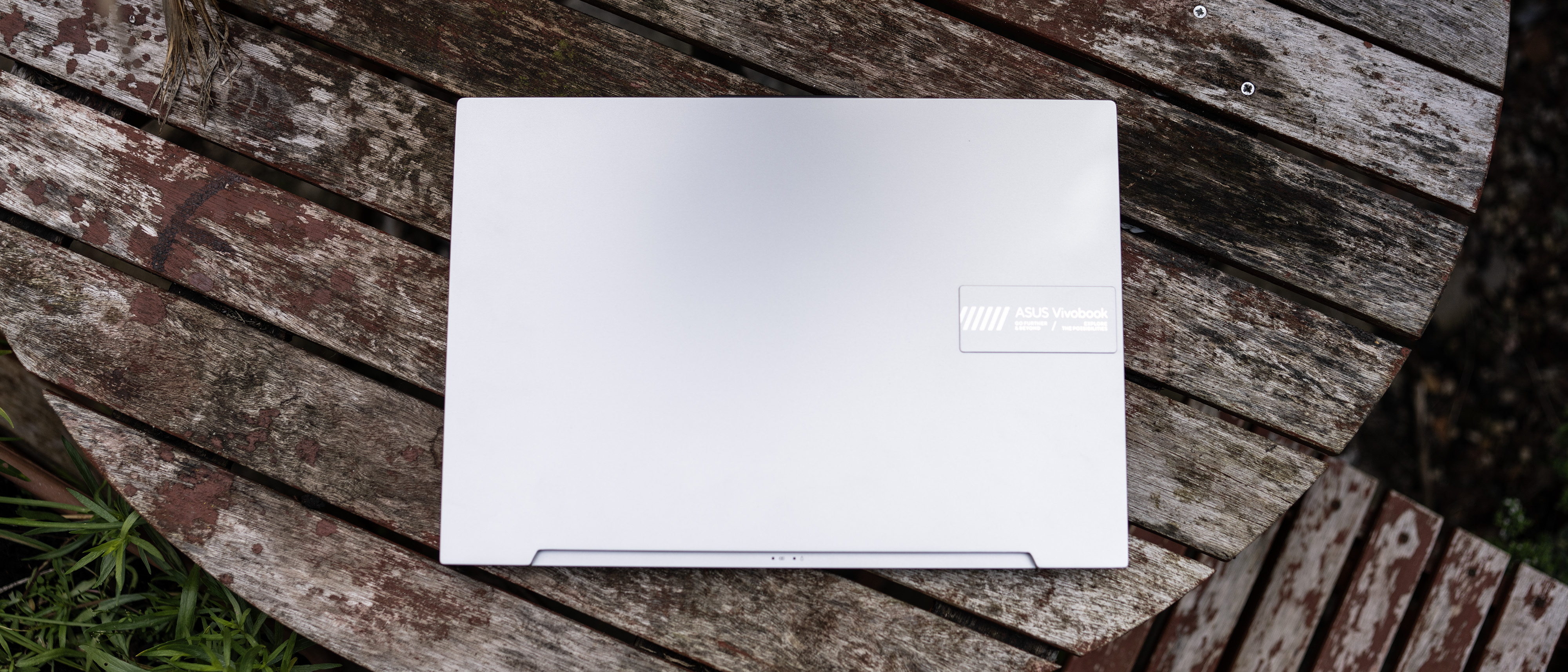Our Verdict
An impressively specced laptop with a gorgeous OLED screen, the ASUS Vivobook Pro 16X is a laptop that will find a use just about anywhere. Its CPU and GPU are some of the most capable on the market right now, and whether it’s gaming, image editing, content creation or just about any other work that involves heavy number crunching, this laptop will rise to the challenge.
For
- Excellent spec
- Lovely OLED screen
- Good connectivity
Against
- Bit heavy
- Short battery life
- Expensive
Why you can trust Creative Bloq
The ASUS Vivobook Pro 16X OLED is the second laptop I’ve reviewed recently to sport a sticker on its lid declaring it to be “The Best ASUS OLED Laptop for Creators” - the other being the ProArt Studiobook OLED. The Vivobook has a similar spec to the ProArt, though lacks the physical dial on the trackpad, and comes in a few hundred pounds cheaper.
And just like its stablemate, this is a well-specced machine that’s going to be attractive to anyone looking for something to use for creative pursuits, gaming, or anything that requires numbers to be crunched or pixels to be pushed in large numbers.
Laptops this large are often bought as desktop replacement machines and don’t do much lap-sitting, so to make them the best laptops for graphic design possible, things like long battery life and cool running are passed over in favour of sheer processing power and graphics performance, two things this Vivobook has plenty of.
ASUS Vivobook Pro 16X OLED review: Key specs
| CPU: | Intel Core i9-13980HX |
| GPU: | Nvidia GeForce RT 4070 8GB |
| RAM: | 32GB |
| Storage: | 1TB SSD |
| Screen: | 16in OLED, 3200 x 2000px |
| Connectivity: | 2x USB 3.2 Gen 1 Type-A, 2x Thunderbolt 4, HDMI 2.1, Ethernet, SD card reader, 3.5mm headset jack, Wi-Fi 6E, Bluetooth 5.3 |
| Dimensions: | 35.50 x 24.90 x 2.19cm |
| Weight: | 1.9kg |
Design and build
The Vivobook model we’re sent for review is a silver one (black is also available) though some madman has come near it with a can of bright orange paint, and left his calling card on the Esc key, the shutter that covers the webcam, and the rubber feet underneath before being wrestled to the ground by security. As such, there's absolutely no chance of you missing Esc to cancel your way out of unwanted dialog boxes, even if the key in question is rather small.
Otherwise, the silver casing looks tastefully restrained, the orange-paint maniac unable to splash his calling card all over it, though we do like the way the Vivobook nameplate is raised on the left-hand side of the lid, along with some platitudes exhorting you to ‘go further & beyond’ and ‘explore the possibilities’. The words ‘Ready to explore’ are written subtly on the back of the screen section near the hinge too, and while it’s not our first choice for a trip down the great grey-green, greasy Limpopo River, all set about with fever-trees (that would be the Dell Latitude 7330 Rugged Extreme), its aluminium casing looks like it might take a few knocks.
Not too many though. Press in on the back of the screen and you’ll see the casing bow in quite a bit, and it’s possible to bend the corners of the screen if you apply some pressure. The same can’t be said of the base, which is solid, adding a degree of heft to a laptop that’s neither thin nor light, but by no means the worst we’ve seen.
Features
The main draw on the outside of the laptop’s casing is the screen, a 3.2K HDR OLED with a 120Hz max refresh rate. It’s not a touchscreen but is everything you’d expect from an OLED panel in 2023 – bright and sharp and colourful, it’s Pantone validated for colour precision and can display 100% of the DCI-P3 colour gamut.
It also has a 16:10 aspect ratio, which is slightly taller than the more common 16:9 widescreen and is a better shape for working with multiple documents and windows.
There's a trackpad, offset to the left and a decent size, and marked out by the presence – or rather absence – of the ASUS dial we saw on the Studiobook Pro. Here, there's just a circle dotted into the corner of the trackpad, inviting you to spin your fingertip there in an impersonation of dial-turning. The chiclet keyboard is gently backlit and the keys are full-size with 1.4mm of travel. It’s very nice to type on, with a feeling of softness beneath your fingers. The numpad is small and squeezed in at the side, while at the top of the screen, the webcam is joined by a privacy shutter, with a sliding switch to cover it over.
Connectivity from the Vivobook is very good, with a pair of Thunderbolt 4 ports, which can be used to connect to monitors or charge the laptop, along with a full-size HDMI 2.1 socket, USB-A and a combo headset socket on one side, and the SD Card reader, USB 3.2 Type-A port, Ethernet and a dedicated charging connection (which it prefers you to use) on the other. Wi-Fi is of the 6E variety, ready to use the latest wireless transmission tech, and there's a Bluetooth 5.3 radio that should be good for wireless keyboards and headphones.
Performance
| Cinebench R23: | Single-core: 2,019 |
| Row 1 - Cell 0 | Multi-core: 17,055 |
| Geekbench 6: | CPU: Wouldn't run |
| Row 3 - Cell 0 | GPU: 33,583 |
| PCMark 10: | 6,673 |
| Handbrake: | 4m 16s |
| Battery life test: | 5h 23m |
With the kind of components found on the inside of the Vivobook 16X OLED, you’d expect a decent level of performance from it, and we weren’t disappointed. You’re going to get excellent performance in Photoshop, Lightroom, Blender and Baldur’s Gate 3 from this laptop.
The CPU is a 24-core chip from Intel’s Raptor Lake architecture – bang up-to-date at the time of writing. It has a maximum turbo speed of 5.6GHz, and wouldn’t be out of place in a desktop workstation.
However, something we noticed was that its multi-core Geekbench scores were higher than those of the ASUS Proart Studiobook, a laptop from the same manufacturer that uses the same components and therefore should have provided broadly similar scores. We can only speculate on what the difference is – a change in the cooling system, perhaps, or the ProArt needing to go back through the Creative Bloq benchmarkeriser for another pass.
Battery life is just about what you’d expect from a laptop carrying this level of computing power. Only the MacBooks really pull away here, with the advantage of a more energy-efficient silicon architecture under their aluminium casings. Our battery life result of just about five and a half hours, using a test that keeps the screen on permanently and runs an office workload including video calls and spreadsheets, is about what you’d expect from a creative workstation laptop in 2023 – the Vivobook is portable, but it’s not something you’ll want to use away from a wall socket for extended periods, especially if you’re hitting the chips harder than our tests do.
It also gets hot underneath. The heat is isolated in two particular places – in the centre at the back below the vents, and over to the middle right of the base, which gives some clues as to where the CPU and GPU are located inside. It’s a computer that’s best left on a desk, and the weight underlines this too.
Should I buy the ASUS Vivobook Pro 16X OLED?
Buying any laptop at over $/£2k is something that’s going to take a lot of thinking about. The ASUS Vivobook Pro 16X OLED has a lot of quality components in it, but is up against a lot of high-end machines, some from ASUS itself, that will rival it in terms of processing power. That said, there's nothing actually wrong with the Vivobook – its OLED screen is nice to look at, it doesn’t run too hot, and there are plenty of ports to connect it to things as a desktop replacement. It’s a jack of all trades, and while it may lack a specific focus, this makes it a good choice if you only want to own one laptop at a time. It’s overkill for web browsing and basic office tasks, but you’ll appreciate the investment when you fire up creative apps.
out of 10
An impressively specced laptop with a gorgeous OLED screen, the ASUS Vivobook Pro 16X is a laptop that will find a use just about anywhere. Its CPU and GPU are some of the most capable on the market right now, and whether it’s gaming, image editing, content creation or just about any other work that involves heavy number crunching, this laptop will rise to the challenge.

Ian Evenden has been a journalist for over 20 years, starting in the days of QuarkXpress 4 and Photoshop 5. He now mainly works in Creative Cloud and Google Docs, but can always find a use for a powerful laptop or two. When not sweating over page layout or photo editing, you can find him peering at the stars or growing vegetables.

